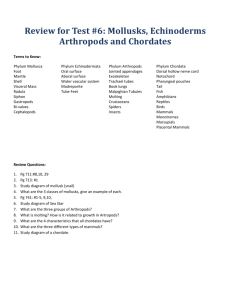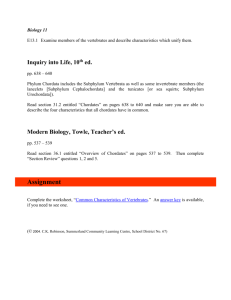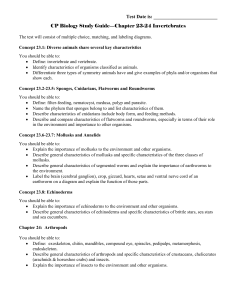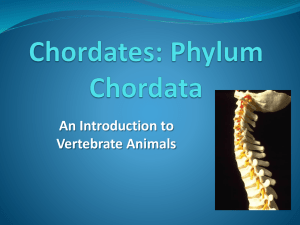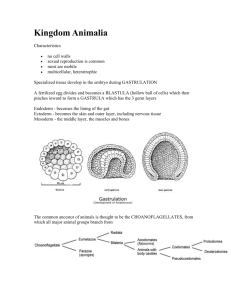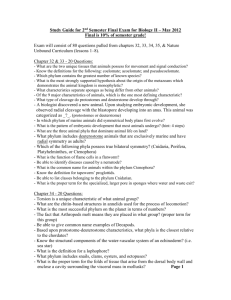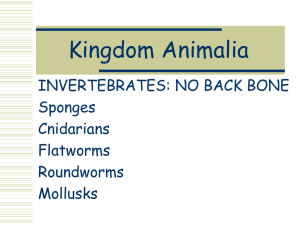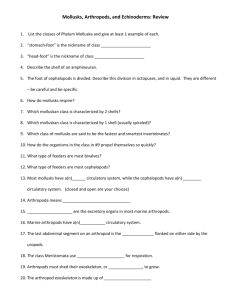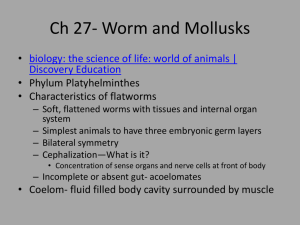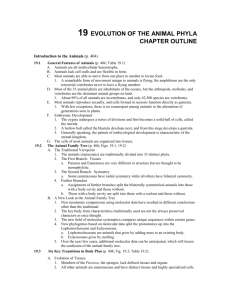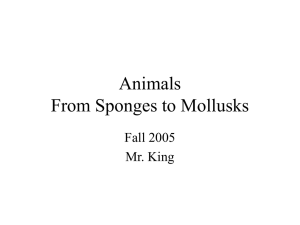Invertebrates
advertisement
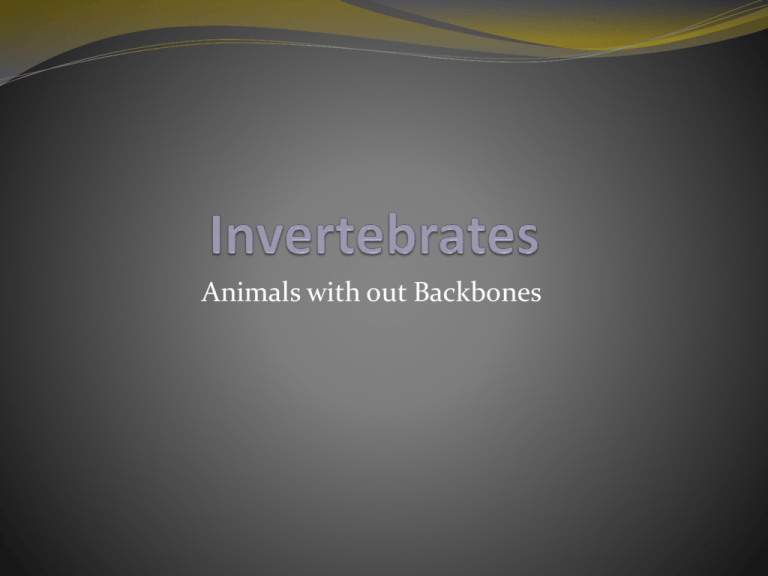
Animals with out Backbones Asymmetrical animals that are a variety of colors, shapes, and sizes Sponges Phylum Porifera- means pore-bearer Sessile organisms Filter Feeders Feed by filtering small particles of food from water Reproduction Hermaphrodites- produce both sperm and eggs Fertilization Internal External Jellyfish, Corals, and Sea Anemones Cnidarians Two body forms Polyp- the stage that has a tube-shaped body form with a mouth surrounded by tentacles Medusa- body form shaped like an umbrella with tentacles hanging down Digestion Nematocyst- a capsule that contains a coiled, threadlike tube that may be sticky or barbed and contain a toxin. Capture prey Gastrovascular Cavity- a space inside the body where digestion takes place, one opening (Mouth) Cnidarians Nerve Net Conducts nerve impulses from all parts of the body No control center Impulses produce contractions of the muscle like cells Reproduction Asexually- budding of the polyp Sexually- eggs and sperm released into the water Tapeworms, Flukes, Planarians Flatworms Contain a brain like structure called the Ganglion Sends messages to body through two nerve cords Receive messages from Eyespots and Sensory Pits Digestive System Contains one opening the Mouth Tapeworms and Flatworms are parasitic Roundworms Smaller then Flatworms Tapered at both ends First Animals with two openings in the digestive system Free-living and Parasitic Mollusks Bilateral Symmetry Two body openings Muscular Foot Mantle A thin membrane that surrounds the internal organs Secretes the shell Mollusks Gastropods- one shelled mollusk Stomach-footed Includes Snails, Slugs, and Sea Slugs Simple Nervous System Small Brain and associated nerves Circulatory System Contain a heart Have open circulatory system- heart pumps blood to vessels then to open spaces First with Respiratory structures called Gills First with Evolved Excretory structures Nephridia- organs that remove waste from body Mollusks Bivalves- two shelled mollusks Clams, oysters, and scallops Sessile animals- filter feed Cephalopods- head footed mollusks Octopus, squid and chambered nautilus Closed Circulator System Foot is Tentacles Advanced Nervous System Bristleworms, Earthworms, Leeches Segmented Worms Body divided into Segments Allows for specialization Bilateral with two digestive openings Jointed-Leg Animals Arthropods Jointed appendages allowed for more powerful movements and increased locomotion Exoskeleton-protects and provides structure for internal organs Most Molt (Shedding of Exoskeleton) in order to increase size Respiration- three types of respiration structures Gills- Crabs, Lobsters Tracheal Tubes- branching networks of hollow air passages with openings in side called Spiracles- Insects Book Lungs- air-filled chambers that contain leaflike platesSpiders Arthropods Groups of Arthropods Arachnids- Spiders, Scorpions, Mites, Ticks Crustaceans- Crabs, Lobsters, Shrimps, Crayfish, Barnacles, water fleas, Pill bugs Centipedes Millipedes Insects Starfishes, Brittle Stars, Sea Urchins and Sand Dollars, Sea Cucumbers, Sea Lilies and Feather Stars Echinoderms Contain an Internal Skeleton Radial Symmetry Water Vascular System- used to move, exchange gas, capture food, and excrete waste Tube-Feet with Suction Cups on the end with the Ampulla (round muscular structure) on the opposite end that works like an eyedropper Hydraulic water pressure system Simple Nervous System-Nerve Net with cells that detect light and touch Sea Squirts and Lancelets Invertebrate Chordates Contain no Backbone All Chordates have the following Notochord- long, semi-ridgid, rod-like structure Dorsal Nerve Cord- a bundle of nerves housed in a fluid filled canal above the notochord Gill Slits Invertebrate Chordates Sea Squirts Sessile As adults the y only contain Gill Slits As larva they posses all the features common to chordates Lancelets Retain all Chordate features in Adult life Live in Borrows

